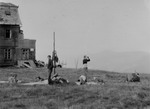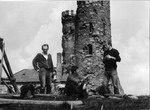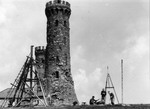The name of river is probably derived from the name of tribe MARAVA, leaving around this river, between the tribes of Serbs and Croats. From same root of tribe name are then the name of region Morava and the name of our village derived.
 (extract from Chronicle II, volume 79) (extract from Chronicle II, volume 79)
The village Morava, as Bohemian part (in comparison to Moravian part), is documented from the year 1577. Its division to Horní (upper) and Dolní (lower) is documented from the year 1720 on the Müllers map of Bohemian Kingdom.
The Moravian part Velká Morava is documented in the year 1564, when the local bailiff Bene Ditrich was mentioned. The village belonged in these time to lordship Branná (Koltejn). The upper part of Velká Morava formed then a separate village called also Horní Morava. This is documented in the year 1732, when its land register was opened. Dominating element of village is the church of St. Alois, built in the year 1801 on spot height 633 a.s.l. A brick chapel is on the beginning of village, its age is about 200 years.
From history of the region
The first information on habitation of foothill of mountain Králický Sněník we have from the year 1325. They were the villages Stubenseifen and Spieglitz (Stříbrnice). The mountains became their first name from the village Spieglitz-Spieglitzer Schneeberg-Stříbrný Sněník (=silver snowy hill). The margrave Karel (Charles, later Karel the 4th), authorized, in name of his father King Jan Lucemburský (Joan from Luxemburg), the mining master Karel Knapp for exploration of upper part of Sněník mountains. Despite of finding some marks of noble metals, he gave us the exploration because of unfavorable conditions and he concentrated the lower locations around the municipally Staré Město. The marks of former prospecting for silver have been visible long time thereafter, but the works were fully stopped during the Thirty years war. A stone hut, view tower and restaurant were built up on the top of Sněník in the years 1895 9 for needs of tourism. The view tower had 5 floors and a height of 33,5 m. The crib hut U pramene Moravy (At well of Morava, former Lichtensteins hut) was demolished in the year 1971, because of emergency state; the hut was built up in the year 1912 with a branch of German society in Staré Město. The view tower on polish side which had the same luck was blasted off in the year 1973.
The last building staying near the top also now, is a small sculpture of en elephant, built up on a pylon from stone blocks. But even this shows the influence of rough weather and vandalism. The surface of initially smooth processed granite sculpture is weather worn now, the elephant tail is broken and the pylon had to be fastened with two high concrete footers. This elephant sculpture became a symbol of Králický Sněník during the past time.


 |





































